|
FEBRUARY 2021
|
|

|
|
May
30, 1919: A Civil War veteran, dressed in his old Zouave
uniform,
proudly holds aloft a tattered American flag as he watches
Hicksville
's
Memorial Day parade - such as it is.
The scene is Broadway, facing
northeast, towards the corner at
East Marie Street
.
Image
based on a Hicksville Public Library Historic Photograph,
found online in the New York State Digital Collections; more
information about this image will be found in the Appendices
|
|
Introduction
|
Everything had been planned, and May 30, 1919 was going
to be a different kind of Memorial Day.
The Great War was over now, and the first of those returning from
it were slowly trickling back. The
scent of victory lingered in the spring air, mixing with that of grief.
Three families, and many friends, were mourning men whose remains
lay buried in
France
. There had been no final
farewells - no hand momentarily placed on a coffin, no clod of earth
tossed into an open grave.
Further down the road, the village would celebrate.
On Independence Day, those who had come back would be part of the
grandest celebration
Hicksville
had ever known. The laughter
and music would eventually subside that day, but afterwards their names
would remain, enshrined in bronze on the new War Memorial in the
Triangle.
|
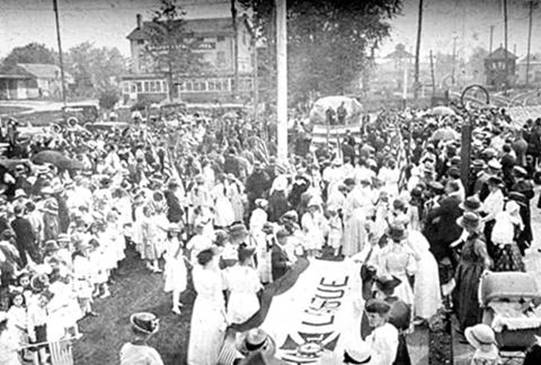
|
|
Welcome
Home Celebration, July 4, 1919
The plaque on the boulder soon will be unveiled.
Hicksville
Public Library Digital Images at https://nyheritage.org
(digitally restored)
Note:
In the foreground, the members of the Epworth League
have yet to roll up their parade banner.
|
But that was more than a month away.
Sadly, today belonged those who had not - would never - come
back: Sgt. Joseph Barry, Cpl. Walter Wheeler, and Pvt. Charles Wagner.
As always, a key part of the annual rite through which
Hicksville
honored its dead veterans would be a parade through the heart of the
community. It would pause at
the Triangle for remembrance ceremonies, and then continue on to
Plain
Lawn
Cemetery
, where the community could pay homage at veterans' graves.
Three young oaks had been planted near the new War Memorial, and today
they would be dedicated to the memory of the absent soldiers.
Perhaps in years to come, this copse would become a place where
loved ones of the deceased could find solace.
Despite
the plans, and despite the solemnity of the Day, the parade would go
awry.
|
***
|
|
Background:
An Uneasy
Hicksville
|
A century later, one thinks that the townspeople would
have done everything possible to make that year's parade a dignified
and fitting experience for the families of the deceased soldiers.
One is wrong to think that.
Why? Imagine
an unsettled community, in which everything seemed to be changing.
A society characterized by rivalries and factionalism.
One in which responsible people defied laws, confronted police,
and rioted. One in which
nominally patriotic organizations bullied immigrants, and persecuted
people because of their race and religious beliefs.
One in which working people feared the loss of their livelihoods.
A village in the throes of an influenza pandemic, which its
government refused to acknowledge.
This was
Hicksville
in 1919, and when the moment was right, the community's loss of three
young soldiers, and the pain which their families still felt, didn't
count for much. Let's look
at the reasons why so many people were on edge that day.
Note: Some readers of Ancient
Hixtory will find portions of this Background section familiar.
Appendices to this article provide links to some further
information about what is said here.
Also, please note that the author's comments below about
German-Americans are not colored by personal considerations; my own
ancestry is Lithuanian-Polish, and my wife's is Ukrainian-Czech.
Not the Same Village Anymore
A decade ago, the East River railroad tunnels had
opened Long Island to city dwellers, and new people with new ethnicities
had begun settling in
Hicksville
. The size of the school on
Nicholai Street
had been effectively doubled around that time, but the village had since
grown so much that the school was again out of room.
Some grades had resorted to split-sessions.
It was clear that the village's largely German values and traditions
were being overshadowed by a mix of new ones.
German-Americans also saw that the anti-German feelings of the
war years were slow to recede. Other
groups felt threatened, too, for
Hicksville
's tolerance was diminishing. When
the Reconstruction-era fable of the "noble" Ku
Klux Klan was revived in
America
, it found ready acceptance on
Long Island
. Perhaps that was due to
the northward migration of some Southern whites in the early years of
the century, perhaps not. For
whatever reason, hatred of blacks, Jews, Catholics, and immigrants in
general now was in fashion.
It would take only a few more years for the Board of Education to openly
welcome the Ku Klux Klan into
the auditorium of
Hicksville
's new junior/senior high school:
Other, more subtle, "patriotic" organizations
shared some values with the Klan,
primarily opposition to immigrants.
As their members quietly networked their way up the social
ladder, their attitudes and policies weighed heavily on many newcomers
to the village.
Feeling Helpless
The combination of skyrocketing land prices (due to
ever-growing demand for new commuter homes) and an unstoppable blight
that ruined crops, made clear that
Hicksville
's agricultural base would not endure.
Someday (no one could predict just when) it would not be possible
to survive in
Hicksville
by owning a farm, by working on one, by supplying one, or by selling the
produce from one - because there would be no more farms.
What would people do then?
There also was a communal sense of lost autonomy.
Albany
had decided to replace local police in many villages, including
Hicksville
. Resistance was futile, but
there had been resentment, which culminated in a riotous encounter
between two troopers and a half-drunken mob.
|
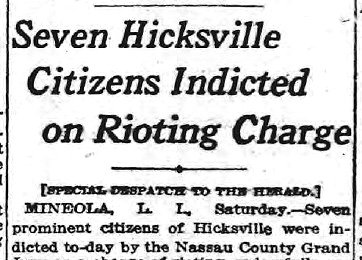
|
|
New
York
Herald, January 20, 1918
|
Prohibition - a Federal initiative which would arrive
with the New Year - was another problem beyond the community's
control. Individual
Hicksvillians stood on both sides of the issue, but the village itself,
insofar as it could have a single voice, opposed it.
Hicksville
's hotels were important, socially and economically.
Even without Prohibition, their future looked challenging.
As
Nassau
County
"suburbified," acreage of nearby undeveloped land would keep
shrinking; game and other wildlife would have to move east.
Parties of hunters and sleigh riders from the City would no
longer choose
Hicksville
as their base. Some of the
local hotels might survive, in scaled-down form, offering banquet space
for local events, and plenty of German cuisine and hospitality, complete
with beer. People thought
that Prohibition would kill the hotels, and with them, the last public
vestiges of the German immigrants who had made
Hicksville
thrive for the first time.
The worst reason for the villagers to feel helpless was
one felt very personally. That
spring, a new wave of influenza hit.
Despite the efforts of the
U.S.
government to censor news of it, people who read the Daily Eagle saw the frightening statistics of what was happening in
Brooklyn
, and that news squared with what was happening nearby.
When the flu struck a family, the young and most fit were even
more likely to die than the frail and elderly.
Everyone knew what was going on, but absolutely no one knew what
to do about it, other than to clench one's teeth and carry on.
Friendly Opponents Become Enemies, Scene 1
As the war ended, villagers had established a Welcome
Committee, to begin work on a War Memorial, and to plan a grand day
of festivities, to be held once all the local soldiers were back.
Enthusiasm was high, and many people volunteered.
In consequence, the Committee
was a large, unwieldy, grass-roots effort.
Its leader, Joseph Steinert Jr., appears to have done a good job
at making progress.
Things moved slower once people had to consider certain details,
primarily the final list of those who were to be named on the memorial.
There were several men over whom people disagreed strongly.
For example, a villager who had manned a government shore
artillery battery during the war, and thus had been exempted from
military service - had he not served his country as it decided he
should?
|
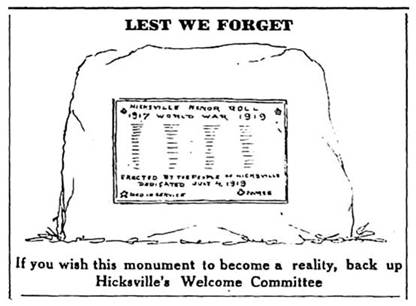
|
|
Look
familiar? This was
the original Welcome Committee
proposal for the War Memorial, which was used to garner
community approval and to solicit funds for creating it.
Huntington
Long-Islander, January 24, 1919
|
For
reasons unclear (one suspects a Machiavellian plot), the friendly but
unwieldy group soon morphed into a tightly-run smaller group, led by Dr.
Elwood Curtis, a local political opponent of the Steinert family.
Perhaps because it wanted to seem more authoritative, the small
group chose to ally itself with a national organization, and henceforth
called itself the Welcome Home Committee of the Patriotic
Order, Sons of
America
.
|
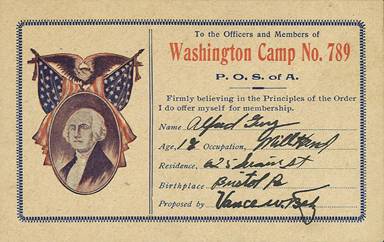
|
|
POSA
Membership Application
Wikipedia
Other
than a referral by an existing member, the application does
not ask for much, but it does want to know where you were born
-
not surprising, in light of POSA's concerns about immigration.
|
Many villagers were bitter about the change.
The original committee had reported to the community, and no one
else. It had done all the
groundwork, and now it would not get credit for its efforts.
The parents of the deceased soldiers were immigrants, and the POSA
opposed immigration. Townsfolk
were suspicious of Curtis, not a native son, who maintained close ties
with the City and
New Jersey
.
Moreover, the revamped group disowned the existing Welcome
Committee's agreement with
Hicksville
's highly-regarded Sutter Works, instead giving the job of making the memorial to a
non-local firm. Joseph
Steinert, Jr. had a letter which lamented this change published in the Long-Islander. Elwood
Curtis promptly responded to that letter with one of his own, which
blamed the change on demands reportedly made by Fred Sutter (son of the
monument works' founder Daniel Sutter, who was one of the early German
settlers). Sutter then had a
letter published, refuting Curtis's allegations.
Which truth should one believe?
Friendly Opponents Become Enemies, Scene 2
For centuries, in religious, philosophical, and
everyday English, the noun Temperance
had primarily denoted moderation,
perhaps with a soupçon of modesty
in behavior added. In
the early 1900s, however, its primary definition was not at all
temperate, but extreme: total abstinence from alcohol.
Obviously,
as enacted, Prohibition did not work in the
U.S.
I shall mention just one of
its shortcomings, which I feel is relevant to understanding
Hicksville
in this era: it played into the hands of the Klan. Because the
latter group publicly supported Prohibition, it was able to ally itself
with people in authority - religious leaders, and also those in key
civil positions, such as School Board members and government officials.
Once that was done, the KKK
was free to recruit parishioners, teachers, lower-level government
workers, etc., and try to persuade them to embrace its base ideology.
The Klan also levered
the public's Prohibition sentiment to discredit and agitate against
groups who regularly used wine - specifically, Roman Catholics because
they consecrated wine at Mass, and Italians, who often made wine, and
drank it at home as part of meals.
Ironically, while the Klan got
many warm receptions, honest proponents of Prohibition sometimes were
treated as their townsfolk's enemies, especially if they belonged to
activist organizations. Judging
by the period newspapers, the most prominent prohibitionist organization
in and around
Hicksville
was the Woman's Christian
Temperance Union. It
regularly sponsored lectures, held working meetings, attended regional
conventions, participated in rallies and demonstrations, etc.
Of course, women were not alone in doing this work;
Hicksville
also had an active chapter of the International
Order of Good Templars, a men's organization with similar
objectives, which received less publicity.
|
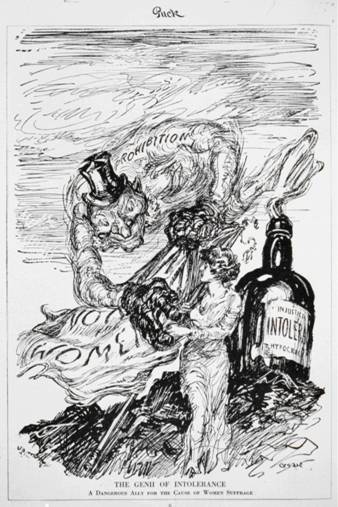
|
|
Cartoon
warning of the dangers of merging the causes
of Women's Suffrage and Temperance, published in
the now-legendary international magazine Puck
wikipedia.org
|
The
fact that women in this era also publicly demonstrated for women's
suffrage may have hurt, or at least delayed, both causes.
Many people (especially men) had believed early on that if women
could vote, they would enact Prohibition.
Almost conversely, they also believed that if Prohibition were
enacted first, the chances of reversing it would be nil if women could
vote.
Either way, with regard to the women of the WCTU,
that manner of thinking left a very unpleasant taste in the soon-to-be
dry mouths of many men.
|
***
|
|
Things
Unravel on Memorial Day
|
The day happened to coincide with the regular
publication date for the weekly Long-Islander.
In that morning's issue, the paper again printed the day's
program, per the POSAWHC (in
case you've forgotten, that's the acronym for the Patriotic Sons' committee).
|
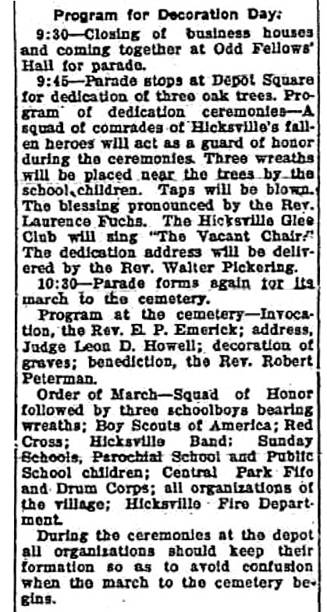
|
|
Huntington
Long-Islander, May 30, 1919
|
This program seemed fine when people saw it, but few
readers considered its incendiary possibilities.
All the community's groups were invited to march, and they would carry
(as groups still do in parades today) large identifying banners.
What if two adjacent groups hated each other?
Imagine what might happen today if, say, the Jewish
Defense League group stood waiting in line directly in front of the KKK klavern (i.e., local chapter).
Things were not quite that bad, but the Prohibitionist WCTU women soon were engaged in, shall we say, a lively discussion
with some presumably hard-drinking firemen (stationed at the rear of the
parade, the Fire Department probably was mustering just behind the
women). Dr. Curtis tried to
quell the dispute. The
firemen proposed that peace would be restored if the WCTU
women did not carry their banner in the parade, and instead carried an
American flag. The women
refused, likely pointing out that every other group in the parade was
displaying its own banner.
The Hicksville Band, hired in
advance for the parade, perhaps had been warned of trouble, for the
night before, it had withdrawn from the parade, leaving POSA
no time in which to book a replacement.
Fire Chief Braun now withdrew all his men from the parade -
despite the late Cpl. Wheeler's having been one his firemen!
Remarkably, the majority of the newly-returned veterans also
withdrew from the parade that was meant to honor their fallen brethren.
In a very few minutes, more than half the intended participants had
decided that marching to honor dead veterans mattered less than
exhibiting their own anger - anger at something that was immutable,
and that had been decided not in Hicksville, but in Washington D.C.
The Central Park (i.e., Bethpage)
Fife
and Drum Corps would still march, but it had been scheduled to start
late in the parade, and it would not arrive for at least an hour.
Uneasy during the wait, some marchers decided to leave the parade
and head off to the ceremony site. They
would have been uncomfortable, for the dropout firemen and veterans were
nearby, and they intended to walk - but not march - alongside the
parade as it went. People
likely expected that those who marched in the parade would be heckled
along the way.
The next edition of the Long-Islander
reported that the parade ultimately consisted only of the
Fife
and Drum Corps, the Squad of Honor, a handful of the men who had
recently returned from service, and many children.
Although it did not mention the village organizations, the
stalwart women of the WCTU
must have marched as well - for if they had withdrawn, the firemen
would have rejoined the parade. The
coverage was both embarrassed and embarrassing.
What had happened was an "unfortunate incident" that had
"marred" the day's solemn observance.
No words scolded those who had instigated the purposeless
walkout, or those had who joined it.
It included a laughable letter from the POSAWHC,
which stated that it had met its objectives (i.e., it maintained that
there had been a parade - though many villagers would have disagreed
about that - and ceremonies). Many
regrets were expressed, but no one assumed, or was burdened with,
responsibility. No apology
was offered to the mourning families, or to the other villagers who had
done their best to respect the dead.
That Memorial Day observation was to be the closest that those three
men's families expected to ever get to funerals for their sons, and
some hotheads did all they could to hijack it, just to grab some
attention.
There are three Appendices.
The first explains the Civil War veteran's unusual uniform;
the second discusses issues that are implicit in the HPL
Historical Photograph used to open the article, as it now resides
online at nyheritage.org; the third offers links to
deeper background information.
Appendix I: Zouaves
In the 1830s, when
France
held part of North Africa, a French regiment of Zwawa tribesmen was celebrated throughout
Europe
because of its victories over other Algerian forces.
People saw pictures of the colorful Zwawa (pronounced Zouave
by the French) uniforms, and they loved them.
Their aesthetic resonated with Romanticism,
the movement which was then sweeping
Europe
, transforming the trappings of Western culture, and bringing to
prominence poets such as Byron, and artists such as Delacroix. Zouave
uniforms spread through the French infantry, and soon, the forces of
other countries, too, including
Spain
and
Italy
.
|
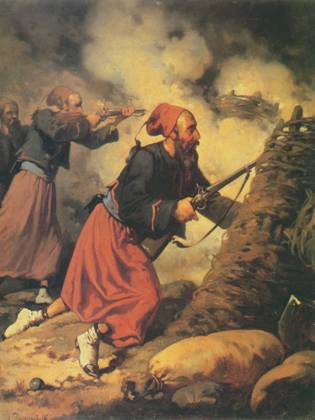
|
|
French
infantry fighting in the Crimean War
Aleksander
Raczyński 1858
Wikipedia.org
|
It was not long before Zouave uniforms made their
appearance in the
United States
, when a Zouave Drill Team toured the nation.
After that, every American boy wanted to be a Zouave.
Merchants sold children's Zouave uniforms, as fast as their
descendants would sell Davy Crockett hats a century later.
When the Civil War began, those boys had grown into adults, and many of
them were happy to make themselves easier targets by wearing dashing
Zouave garb. There were
Union Zouave regiments. There
were Confederate Zouave regiments.
New York
State
alone had multiple Zouave regiments.
Some of them won fame - at the First
Battle of Bull Run, Gen. Stonewall Jackson called the Fifth New York
"Red-legged Devils."
|
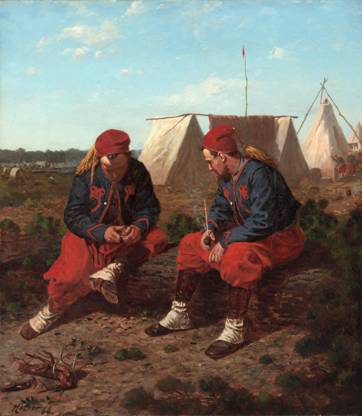
|
|
Infantrymen
of
New York
's 5th Regiment
The
Brierwood Pipe, Winslow Homer, 1864
Wikipedia.org
|
|
**
|
Appendix II: The Story of the Photograph
Regular readers of Ancient Hixtory
- there may be some - know that I sometimes voice frustration
(i.e., rant childishly) about badly-taken and badly-handled old
photographs. I am always
sincerely grateful that historic images exist in any form, but I hate to
find an old picture that may be one-of-a-kind, and realize that it could
have been much better, and could have communicated better, had someone
only given a little more thought to taking or preserving it.
My rant this time is complicated; I'll do my best.
When we look at the image we see online (below, left) we're obviously
looking at a picture, likely a transparency, taken in a darkened room
during a lecture of some sort. The
subject of this picture is an image projected on a screen, which appears
distorted because of the angle of the screen relative to the camera
used. The blue fringes
around the silhouetted heads in the foreground tell us two things: color
film was used, and the film and lens could not handle the extremes of
the lighting very well. Hence,
the lecturer's slide was more detailed and clear than what we see.
|
"Raw" Online Image
|
Geometrically Corrected Image
|
|
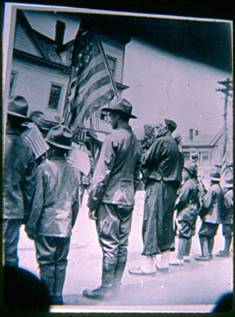
|
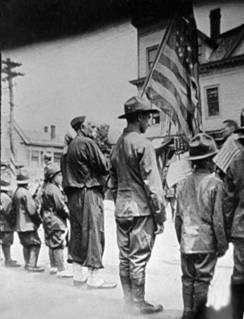
|
|

|
If we had the name of the lecturer, or knew where the
lecture was given, we might be able to track down the lecturer's
slide, and perhaps even the source from which it was made, and thus be
able to learn more from a higher-quality image.
Alas, the only metadata about the image available at HPL
Historic Photographs at nyheritage.org
is the description you see shown with it above - a description which
ignores the man in the Zouave uniform!
I made corrections to the image as found.
I restored its color state to monochrome.
I rectified the tilt. I
improved the distorted perspective geometry, which was introduced by the
angle from which the last slide was made.
I "removed" the distracting foreground heads.
And finally, I flipped the image horizontally, because it already
had been reversed in error. How
do I know this?
In 1919, the
Kallert
Building
(below) stood on the southeast corner of Broadway and
Marie Street
. It had been repainted and
remodeled over the years, but its square tower with overhanging
roof remained distinctive.
|
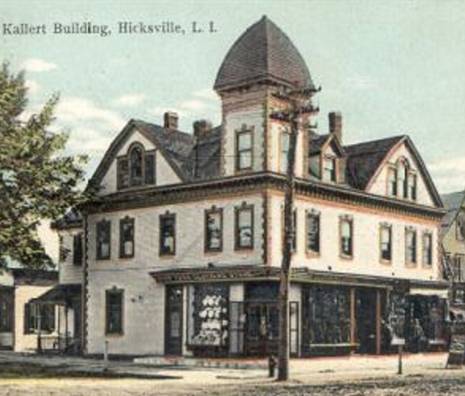
|
|
Kallert
Building, extracted from an image found on
longislandgenealogy.com/PCsMThomas/ImagesOfOldLI.html
|
|

|
Our picture shows the Kallert across the street from where the photographer was, but as
noted in the above diagram, things look wrong.
A look at other sources of local historic images, including one
created by fellow HHS graduate Mark Thomas, gives us the clue that
explains things. When
looking at the small dormer in the Kallert,
we see it the right of
the corner tower, but in the online image, it is partially visible
(along the upper edge of the flag) to the left
of the tower. The only
possibility is that image has been flipped over.
Unflipping it shows that the photographer was standing on
Broadway, and the distant buildings were on
Marie Street
(a fact that is easily confirmed by looking at other historic
photographs).
Most likely, the image was donated to the Library as a
slide, and the slide was flipped over at some point, and scanned as a
mirror image of itself. To
resume my rant for a moment... to make such an error, and not double
check, when producing something for public viewing is inexcusable.
It is easy to verify which side of a slide is front and which is
back. Oh well.
The text on NYHeritage
notes that "The boys [are] wearing Doughboy uniforms...."
This is unlikely, although children's Army uniforms were indeed
sold during the war. It is
more likely that the children are Boy Scouts, who were out for the
parade, and who in that era dressed in vaguely similar uniforms.
I suggest that the adult among them was wearing a Scoutmaster
uniform; an adult civilian would not have dared to wear a fake doughboy
uniform in the presence of real soldiers.
A tell-tale difference from soldiers' uniforms is the lack of
epaulettes. Another is that
the boys are wearing gaiters over their lower legs, whereas - like my
father's brother Gus in this wartime photograph - real doughboys
wore wrap-around puttees:
|
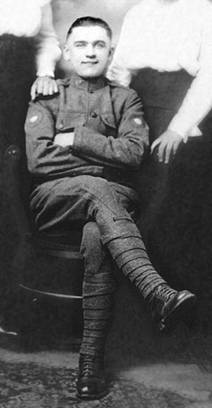
|
|
Ron's
Uncle Gus, c.1918
Collection
of Ronald A. Wencer
|
|
*
|
As to the identity of our flag-holding Zouave, and the
coloring I added.... From
records, it appears that at least two men who later lived in
Hicksville
had served in regiments which used such uniforms at the time that their
regiments entered the Civil War. I
phrase it in that awkward way because some Zouave regiments quickly
switched to more easily maintainable (and less visible) "regular"
uniforms once they saw combat.
However, by May 1919, all of Hicksville's Civil War veterans had died,
except for Louis Meyer and Henry Menge (about whom I wrote last month),
and I do not believe that either of them had belonged to Zouave
regiments. I can imagine
Menge's donning such a uniform whimsically, because there was a
Brooklyn
regiment - not the one in which he served, but another with the same
number! - that did wear Zouave uniforms.
I believe, however, based on the only other photo I have seen of
Henry Menge, that he is not the man in this picture.
Enter a mystery veteran. The
Long-Islander separately
reported on another public event which occurred roughly around this
time, at which a
Bethpage
resident turned up, wearing his old Zouave uniform, and bearing a torn
and well-worn flag. He may
well be the man we see above. Unfortunately,
his name must have been reported incorrectly; I have yet to find any
record of him.
For this article, I tinted the uniform match to those of several
Pennsylvania
and
New York
regiments, all of which used the same basic colors.
Photographs and paintings show that their Zouave hats were
inconsistent in shape, even within a single regiment, although they
generally were consistent in color.
Hats which featured trailing gold-colored tassels (often made of
yarn) sometimes had bands of white fur (probably rabbit) around the head
opening, and/or a furry white band further up the hat.
Appendix III: Additional Information
These past Ancient Hixtory
articles cover in greater depth many of the issues described in this
article. A number of them
include bibliographical references.
|
Selected
Ancient Hixtory at Hixnews.com
|
|
Issue
|
Direct Link
|
Description
|
|
June
2018
|
1806/hixtory.htm
|
Hicksville
honors those who served - and died - in
World War I
|
|
November
2018
|
1811/hixtory.htm
|
The
Ku Klux Klan is welcomed in the new high school auditorium
|
|
January
2019
|
1901/Hixtory.htm
|
Some
leading citizens of
Hicksville
riot, because a tail light was not lit
|
|
May
2019
|
1905/Hixtory.htm
|
The
service of the three Hicksville men who died in World War I
|
|
June
2019
|
1906/Hixtory.htm
|
Hicksville's
largest factory, and how beetles caused its demise
|
|
August
2019
|
1908/Hixtory.htm
|
How
the
East River
rail tunnels made L.I. suburbs possible
|
|
September
2019
|
1909/Hixtory.htm
|
Suburban
growth squeezes farms before World War I
|
|
May
2020
|
2005/Hixtory.htm
|
1918:
a pandemic hits, and the government does almost nothing
|
Whew!
That's it.
Good-bye, and Stay Healthy
|















